
The yen is the official currency of Japan. It is the third most traded currency in the foreign exchange market after the United States dollar and the Euro. It is also widely used as a reserve currency after the U.S. dollar, the Euro, and the U.K. pound sterling.
The Australian dollar is the currency of Australia, including its external territories: Christmas Island, Cocos (Keeling) Islands, and Norfolk Island. It is officially used as currency by three independent Pacific Island states: Kiribati, Nauru, and Tuvalu. It is legal tender in Australia. Within Australia, it is almost always abbreviated with the dollar sign ($), with A$ or AU$ sometimes used to distinguish it from other dollar-denominated currencies. The $ symbol precedes the amount. It is subdivided into 100 cents.

The Korean won or Korean Empire won, was the official currency of the Korean Empire between 1902 and 1910. It was subdivided into 100 jeon.
The North Korean won or Democratic People's Republic of Korea won is the official currency of North Korea. It is subdivided into 100 chon. The won is issued by the Central Bank of the Democratic People's Republic of Korea, based in the capital city, Pyongyang.
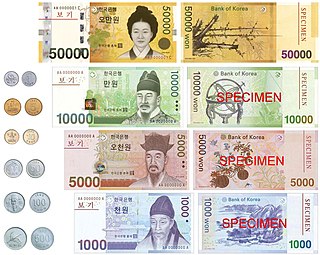
The South Korean won or Korean Republic won is the official currency of South Korea. A single won is divided into 100 jeon, the monetary subunit. The jeon is no longer used for everyday transactions, and appears only in foreign exchange rates. The won is issued by the Bank of Korea, based in the capital city of Seoul.
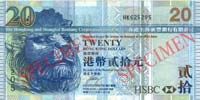
The Hong Kong dollar is the official currency of Hong Kong. It is subdivided into 100 cents. The Hong Kong Monetary Authority is the governmental currency board and also the de facto central bank for Hong Kong and the Hong Kong dollar.

The New Taiwan dollar is the official currency used in Taiwan. Formally, one dollar (圓) is divided into ten dimes (角), and to 100 cents (分), although cents are never used in practice. The New Taiwan dollar has been the currency of Taiwan since 1949, when it replaced the Old Taiwan dollar, at a rate of 40,000 old dollars per one new dollar.

The đồng has been the currency of Vietnam since May 3, 1978. Issued by the State Bank of Vietnam, it is represented by the symbol "₫" or "đ". Formerly, it was subdivided into 10 hào, which were further subdivided into 10 xu, neither of which are now used. Since 2012 the use of coins has decreased greatly, and since 2014 coins are generally not accepted in retail, but will still be accepted in some, but not all, banks.
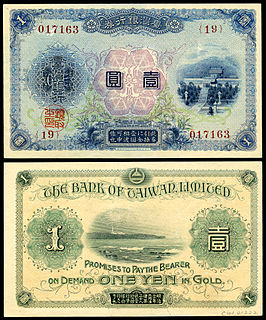
The Taiwanese yen was the currency of Japanese Taiwan from 1895 to 1946. It was on a par with and circulated alongside the Japanese yen. The yen was subdivided into 100 sen (錢). It was replaced by the Old Taiwan dollar in 1946, which in turn was replaced by the New Taiwan dollar in 1949.
The yuan is the base unit of a number of former and present-day currencies in Chinese.

The hwan was the currency of the Republic of Korea between February 15, 1953 and June 9, 1962.
The Old Taiwan dollar was in use from 1946 to 1949, beginning shortly after Taiwan's handover from Japan to the Republic of China. The currency was issued by the Bank of Taiwan. Hyperinflation prompted the introduction of the New Taiwan dollar in June 1949, shortly before the Nationalist evacuation from mainland China in December.
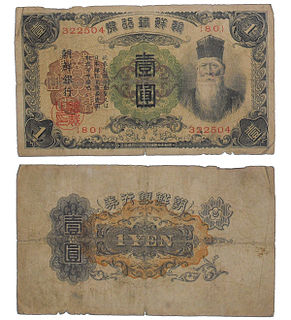
The Korean yen was the currency of Korea between 1910 and 1945. It was equivalent to the Japanese yen and consisted of Japanese currency and banknotes issued specifically for Korea. The yen was subdivided into 100 sen. It replaced the Korean won at par and was replaced by the South Korean won and the North Korean won at par.
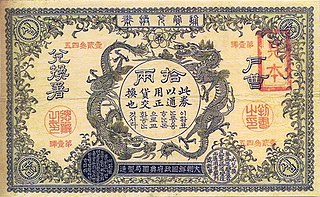
The yang (양/兩) was the currency of Korea between 1892 and 1902. It was subdivided into 10 jeon (전/錢), 100 bun (분/分) and 5 yang = 1 hwan (환/圜).

The mun was introduced as the main currency of Korea in 1625 and stayed in use until 1892. Prior to the mun, cash coins with the inscriptions tongbo (通寶) and jungbo (重寶) and silver vases called ŭnbyŏng were used as currency in the Goryeo Dynasty (918–1392), as well as imported Chinese currency. The mun resembled and was derived from the Chinese wén. Coins denominated in mun were cast in copper-alloys such as brass or bronze and were round with square holes. From the 17th century until the end of the 19th century, coins denominated in mun bearing the inscription Sangpyeong Tongbo, introduced in 1633, were the most widely circulated currency. In 1888, coins were struck in small numbers denominated in mun and won. The mun was replaced in 1892 when the yang was introduced.
The won is the currency of both North and South Korea. "Won" is a cognate of the Chinese currency unit, the yuan (圓/圆/元), and the Japanese currency unit, the yen, meaning "round object". The won is subdivided into 100 jeon.

The Bank of Joseon or Bank of Chosen was the central bank of Colonial Korea, and of South Korea. The bank issued the Korean yen from 1910 to 1945 and the won from 1945 to 1950.
Japanese currency has a history covering the period from the 8th century AD to the present. After the traditional usage of rice as a currency medium, Japan adopted currency systems and designs from China before developing a separate system of its own.

Korean currency dates back as far as the Goryeo dynasty (918–1392) when the first coins were minted. The coins, cast in both bronze and iron, were called tongbo and jungbo. Additionally, silver vases called ŭnbyŏng were widely used and circulated as a currency among the aristocracy of Goryeo.
















